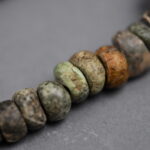Editor’s note: This story appeared in the October 2021 edition of The Daily Universe Magazine.

French archaeologist Dr. Marion Forest and BYU grad student Chloe Burkey worked together in developing a new method of identifying forgeries from authentic ancient Mayan greenstone artifacts.
The two recently finished their two-year project of studying the BYU Museum of Peoples and Cultures’ Mesoamerican greenstone collection. The pair’s research looked into every trace and characteristic of the manufacture of each greenstone artifact. The manufacturing process, the chemical makeup of these objects and traces from specific tools, modern or ancient, became signs of authenticity and illegitimacy, Forest said.
Forest specializes in Mesoamerican sociology; she is primarily a field archaeologist but has been teaching various classes at BYU during a three-year period as a postdoctoral fellow. She said their goals were to provide a truthful understanding of these greenstone artifacts and an artifact catalog for the museum itself and all future museum guests.
Lillian Sanders, promotions manager for the BYU Museum of Peoples and Cultures, expressed great excitement about the research on behalf of the museum. “They have been able to identify the mineralogical composition and manufacturing process of these artifacts, offering a new approach to studying such pieces,” she said.
Burkey hopes their findings promote deeper thought about the importance of authenticity. “Why does authenticity matter? What if we had forgeries in museums — what difference does it make to have authentic artifacts in representing history?” she said.
Burkey graduated in archaeology, with an emphasis in anthropology. She kickstarted the project while being enrolled in a Mesoamerican history class taught by Forest. She approached Forest, asking if she could work with her for her senior archaeology thesis project.
The research became a three-part process, Burkey said. They began with analyzing the chemical structures of the 300 greenstone artifacts. The artifacts’ elements were critical to the identification of which materials would be realistic for the time period these artifacts were supposed to be coming from.
“A lot of the forgeries are made out of cheaper materials that specifically led us to trace the origin,” Burkey said.
The second part of the process was microscopic analysis. Michael Standing has been with the BYU Electron Microscopy Facility for thirty years and is an expert in working with many different types of microscopes. Standing trained Forest and Burkey on how to use the electron scanning microscope, a complicated tool that requires online and in-person training.
“Our whole purpose here is to be available to other researchers. We’re specifically a support facility for whoever needs to utilize us,” Standing said. He emphasized the lab’s desire to further projects and research in whatever capacity they can.
He trained Forest and Burkey on how to use the electron scanning microscope, allowing them to do microscopic analysis on marks left by tools. This intense scanning allowed Forest and Burkey to notice how certain artifacts had similar carving and polishing traits that could only be done by more modern tools.
The third and final part of the project involved the electron scanning microscope again to figure out what chemistries and minerals had been used in the greenstone rocks.

These small artifacts have an incredible value, Forest said. She hopes their research will give new life and identity to the greenstone artifacts. “Instead of being buried in boxes, the museum can now have an authentic exhibit and show everyone these incredible artifacts,” she said.
The team made a 3D model catalog that will be available online. Forest believes so much more future work can be accomplished on top of her and Burkey’s groundwork. She said she hopes their findings make the museum, artifact donors and future researchers proud.
The two women began the primary analysis in the fall of 2019, and worked together throughout 2020 into the fall of 2021. Burkey won the first place award for undergraduate Anthropology project at the 2020 Mary Lou Fulton Conference for mentored student research at BYU.
Forest is hoping for their completed research articles to be submitted for publication by Christmas time this year and will be leaving BYU as her postdoctoral fellowship comes to a close.







